AKG Acoustics DHT700 digital wireless microphone User Manual DMS700 BDA 2 EN3
AKG Acoustics GmbH digital wireless microphone DMS700 BDA 2 EN3
Users manual
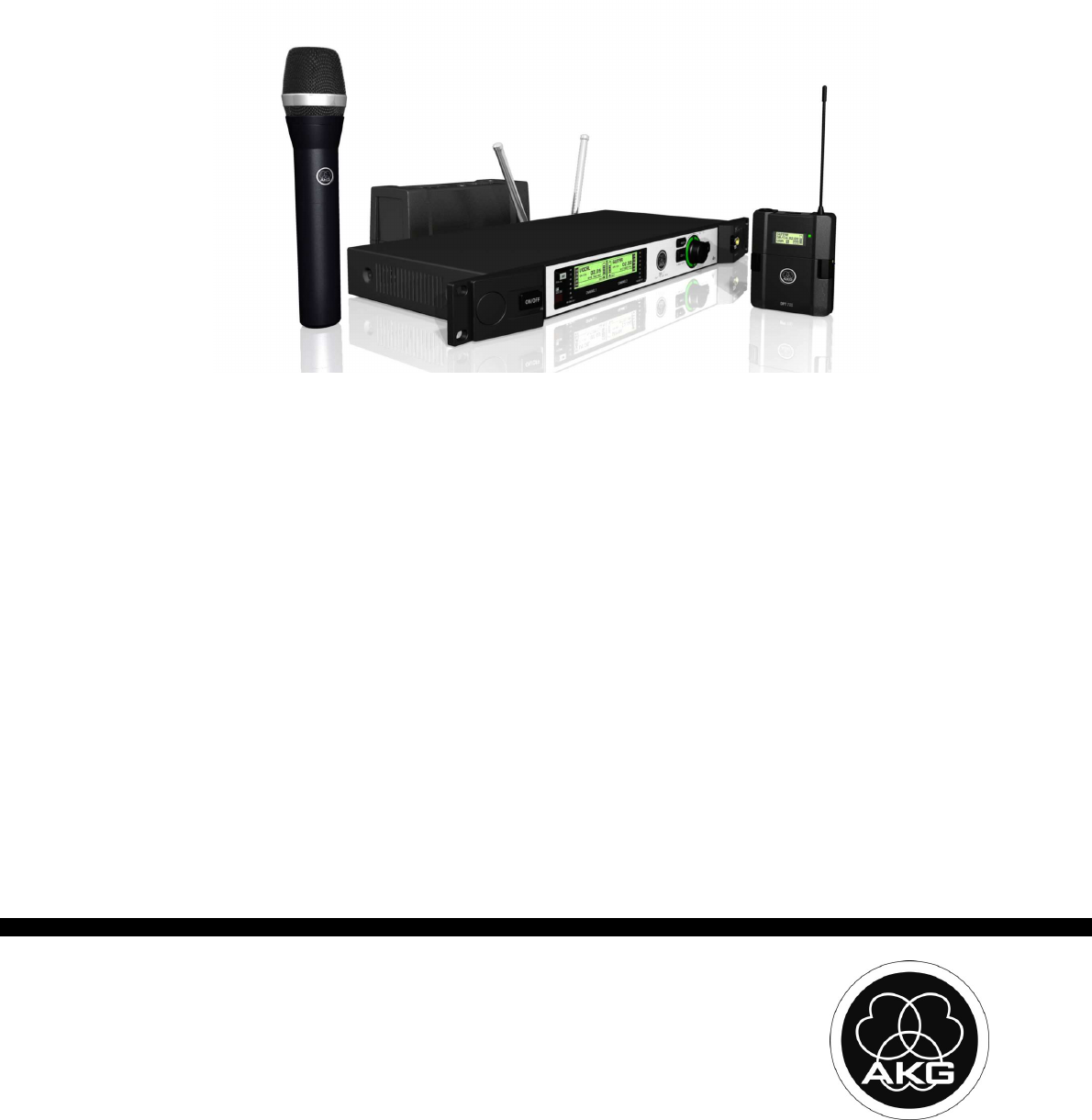
DMS700
Digital Wireless Microphone System
DSR 700 – digital stationary receiver
DPT 700 – digital bodypack transmitter
DHT 700 – digital handheld transmitter
USER MANUAL
Please read the manual before using the equipment!
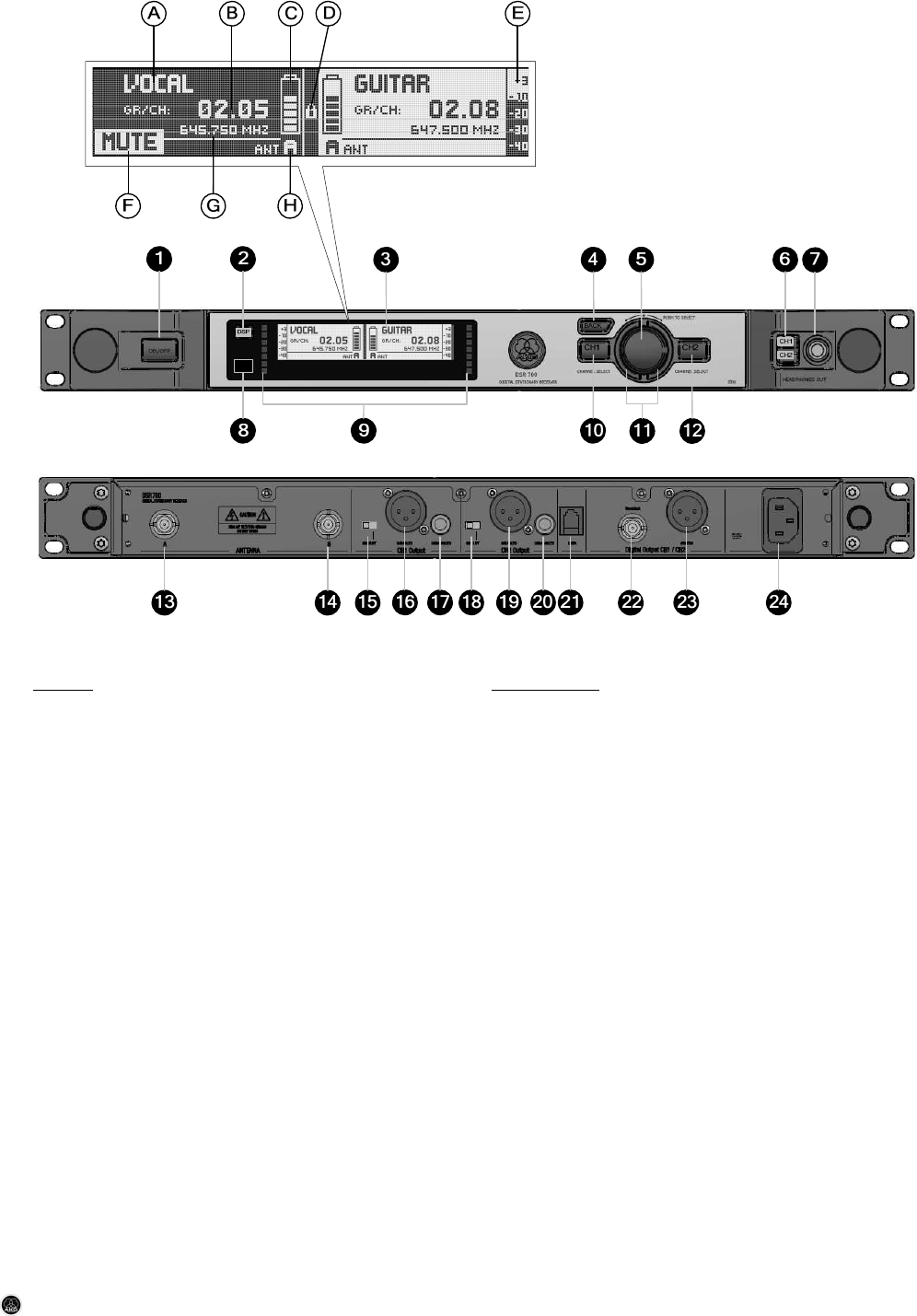
DMS 700 V1.00 2
DSR 700
IR
Controls:
1. POWER: ON/OFF switch
2. DSP-Button
3. Graphic display
4. BACK-Button
5. JOG-Wheel (left, right, select)
6. Headphone Buttons (CH1, CH2)
7. Headphone Output, ¼-Inch/6.3mm jack socket
8. Infrared data synchronization window
9. RF signal level, LED meter
10. Channel selection for channel CH1
11. Backlit status ring for channel CH1 & CH2
(red=warning, green=OK)
12. Channel selection for channel CH2
13. BNC socket, antenna input A
14. BNC socket, antenna input B
15. GND-Lift XLR output channel CH1
16. XLR socket(male), analog audio output CH1, balanced
17. ¼ Inch/6,3mm jack socket, analog audio output CH1,
unbalanced
18. GND-Lift XLR output channel CH2
19. XLR socket(male), analog audio output CH2, balanced
20. ¼ Inch/6,3mm jack socket, analog audio output CH1,
unbalanced
21. Data interface, RJ11 socket to connect device to a
computer (via HUB 4000 Q)
22. BNC socket, AES-EBU Wordclock IN (48kHz)
23. XLR socket(male), digital AES-EBU audio output
CH1 & CH2 (48 kHz)
24. IEC mains connector (90 - 240VAC)
Graphic Display:
A. Alphanumeric display for the name
B. Display of the actual group & channel number
C. 7-digit transmitter battery status display
D. LOCK symbol
E. Audio signal level meter
F. MUTE symbol
G. Display of the actual frequency
H. Display of the active antenna
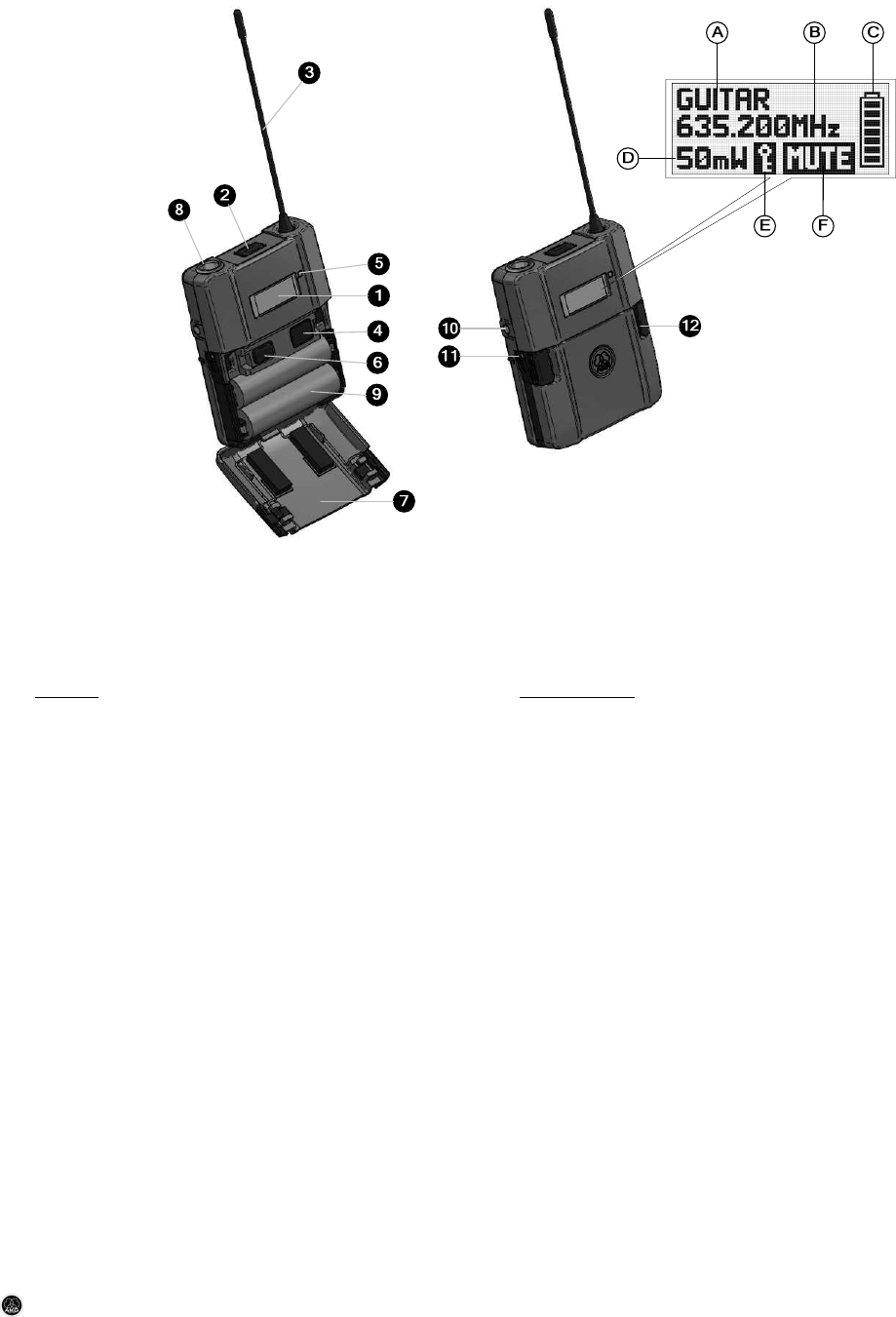
DMS 700 V1.00 3
DPT 700
Controls:
1. Graphic display
2. Mute switch
3. ¼ wave antenna
4. Infrared Window, for data synchronization
5. Status LED (red=warning, green=OK)
6. Power ON/OFF Button
7. Battery compartment cover
8. 3-pin. Male mini-XLR (TB3M), audio input for
microphones and instruments
9. Battery compartment for two 1.5 V LR6 AA batteries or
1.2 V AA rechargeable batteries >2100 mAh.
10. 0.1 inch/2.5-mm jack socket for external mute switch
11. Charging contacts
12. Battery compartment release buttons
Graphic Display:
A. Alphanumeric display for name
B. Display of the actual group & channel number
C. 7-digit battery status display
D. Display for country or RF output level
E. Active encryption symbol
F. Active mute symbol
1
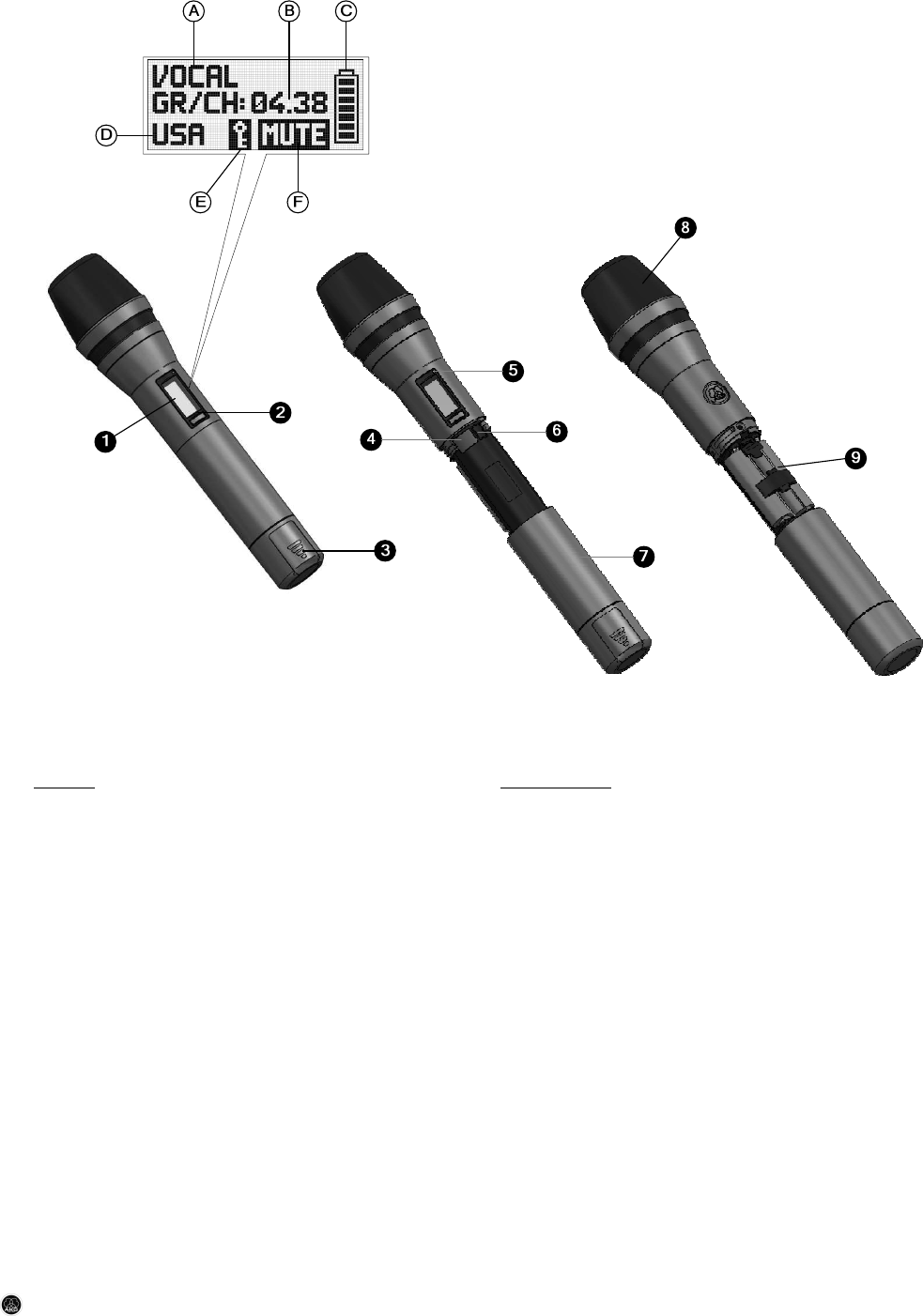
DMS 700 V1.00 4
DHT 700
Controls:
1. Graphic display
2. Mute button
3. Color code, charging contacts, helical antenna
4. Infrared window for data synchronization
5. Status LED (red=warning, green=OK)
6. Power ON/OFF button
7. Battery compartment cover
8. Microphone element
9. Battery compartment for two 1.,5 V LR6 AA batteries or
1.,2 V AA rechargeable batteries >2100 mAh.
Graphic Display:
A. Alphanumeric display for the name
B. Display of the actual group & channel number
C. 7-digit battery status display
D. Display for country or RF output level
E. Active encryption symbol
F. Active mute symbol

DMS 700 V1.00 5
Thank you
for purchasing an AKG product. This Manual contains important instructions for setting
up and operating your equipment. Please take a few minutes to read the instructions below carefully
before operating the equipment. Please keep the manual for future reference. We hope you enjoy using
your system!
Important Note!
AKG continually improves the internal firmware of the DMS 700 system in order to meet changing
customer needs in the best possible way. Should your system use a different firmware version than
the one described in this User Manual, some functions may differ from the related instructions.
To find out the actual firmware version implemented in your system, please check the Menu. The firmware
version described in this User Manual is stated on the cover page. Before you read on, we recommend
comparing the receiver firmware version against the version described in the Manual. If the two versions
are not identical, please visit www.akg.com to find out about the latest changes.
Table of Contents
1.
Safety and Environment.............................................................................................................. 6
Safety .................................................................................................................................................. 6
Environment......................................................................................................................................... 6
2.
Packing List ................................................................................................................................. 7
3.
General......................................................................................................................................... 7
DMS 700.............................................................................................................................................. 7
4.
Setting Up..................................................................................................................................... 7
Connecting Antennas........................................................................................................................... 7
Positioning the Receiver ...................................................................................................................... 7
Connecting the Receiver to a Mixer/Amplifier....................................................................................... 8
Ground Lift (15, 18).............................................................................................................................. 8
Connecting the Receiver to Power....................................................................................................... 8
Silent Mode.......................................................................................................................................... 8
Key Lock / Unlock of the Receiver........................................................................................................ 8
Optional external MUTE switch............................................................................................................ 8
5.
Operating Notes........................................................................................................................... 8
SETUP WHEEL (5).............................................................................................................................. 8
CH1 / CH2 Buttons (10 / 12) ................................................................................................................ 8
BACK Button (4) .................................................................................................................................. 9
DSP Button (2)..................................................................................................................................... 9
Checking Audio Signal – Headphone CH1 / CH2 Buttons (6)............................................................... 9
6.
Display.......................................................................................................................................... 9
General Window .................................................................................................................................. 9
Channel Information Window ............................................................................................................... 9
Battery status information..................................................................................................................... 9
Audio Meter ......................................................................................................................................... 9
MUTE Information (F) .......................................................................................................................... 9
Antenna Information............................................................................................................................. 9
Status & Warning Information .............................................................................................................. 9
7.
DSR 700 Menu........................................................................................................................... 11
Quicksetup – Menu............................................................................................................................ 11
Channel – Menu................................................................................................................................. 12
AUDIO – Menu................................................................................................................................... 12
Envir. Scan – Menu............................................................................................................................ 13
Rehearsal – Menu.............................................................................................................................. 13
Utility – Menu..................................................................................................................................... 13
8.
DPT 700 / DHT 700 Menu.......................................................................................................... 14
Standard Startup................................................................................................................................ 14
Silent Mode Startup ........................................................................................................................... 14
9.
Function Description................................................................................................................. 15
Quicksetup......................................................................................................................................... 15
Channel Menu ................................................................................................................................... 15
AUDIO Menu ..................................................................................................................................... 15
Environment Scan.............................................................................................................................. 16
Rehearsal – Sound Check ................................................................................................................. 16
Utilities Menu ..................................................................................................................................... 17
10.
Cleaning ..................................................................................................................................... 17
11.
Troubleshooting ........................................................................................................................ 18
12.
Specifications ............................................................................................................................ 19
General – DMS 700 Digital Microphone System................................................................................. 19
DSR 700 – Digital True Diversity Receiver........................................................................................ 19
DPT 700 – Digital Bodypack Transmitter........................................................................................... 19
DHT 700 – Digital Handheld Transmitter........................................................................................... 19

DMS 700 V1.00 6
1. Safety and Environment
Safety
• Do not expose the equipment to direct sunlight, excessive dust, moisture, rain, mechanical vibrations,
or shock.
• Do not spill any liquids on the equipment and do not drop any objects through the ventilation slots in
the equipment.
• The equipment can be used in dry rooms.
• The equipment should be opened, serviced, and repaired by authorized personnel only. The
equipment contains no user-serviceable parts.
• Before connecting the equipment to power, check that the AC mains voltage stated is identical to the
AC mains voltage available where you will use the equipment.
• Operate the equipment with voltages from 90-240 VAC only. Using a different output voltage may
cause serious damage to the unit!
• If any solid object or liquid penetrates into the equipment, shut down the sound system immediately.
Disconnect the power cable from the power outlet immediately and have the equipment checked by
AKG service personnel.
• Do not place the equipment near heat sources such as radiators, heating ducts, or amplifiers, etc.
and do not expose it to direct sunlight, excessive dust, moisture, rain, mechanical vibrations, or
shock.
• To avoid hum or interference, route all audio lines, particularly those connected to the microphone
inputs, away from power lines of any type. If you use cable ducts or conduits, be sure to use separate
ones for the audio lines.
• Clean the equipment with a moistened (not wet) cloth only. Be sure to disconnect the power supply
from the power outlet before cleaning the equipment! Never use acidic or scouring cleaners or
cleaning agents containing alcohol or solvents since these may damage the enamel and plastic
parts.
• Use the equipment for the applications described in this manual only. AKG cannot accept any liability
for damages resulting from improper handling or misuse.
Environment
• Be sure to dispose of used batteries as required by local waste disposal rules. Never throw batteries
into a fire (risk of explosion) or garbage bin.
• The packaging of the equipment is recyclable. Dispose of the packaging in an appropriate container
provided by the local waste collection/recycling entity and observe all local legislation relating to
waste disposal and recycling.
• When scrapping the equipment, remove the batteries, separate the case, circuit boards, and cables,
and dispose of all components in accordance with local waste disposal rules.
FCC Statement
The DHT 700 D5, DHT 700 C5 and DPT 700 have been tested and found to comply with the limits for a low power
auxiliary station pursuant to Part 74 of the FCC Rules. The DSR 700 has been tested and found to comply with the limits
for a Class B digital device, pursuant to Part15 of the FCC Rules. These limits are designed to provide reasonable
protection against harmful interference in a residential installation. This equipment generates, uses, and can radiate radio
frequency energy and, if not installed and used in accordance with the instructions, may cause harmful interference to
radio communications. However, there is no guarantee that interference will not occur in a particular installation. If this
equipment does cause harmful interference to radio or television reception, which can be determined by turning the
equipment off and on, the user is encouraged to try to correct the interference by one or more of the following measures:
• Re-orient or relocate the receiving antenna.
• Increase the separation between the equipment and the receiver.
• Connect the equipment into an outlet on a circuit different from that to which the receiver is connected.
• Consult the dealer or an experienced radio/TV technician for help.
Shielded cables and I/O cords must be used for this equipment to comply with the relevant FCC regulations.
Changes or modifications not expressly approved in writing by AKG Acoustics may void the user’s authority to operate this
equipment.
The DSR 700 complies with Part 15 of the FCC Rules. Operation is subject to the following two conditions: (1) this device
may not cause harmful interference, and (2) this device must accept any interference received, including interference that
may cause undesired operation.

DMS 700 V1.00 7
2. Packing List
Check that the package contains all the parts listed above. If anything is missing, please contact your AKG
dealer.
DSR 700
1 x DSR 700 Receiver, 2 x BNC UHF Antennas, 1 x EU-standard IEC Power cord, 1 x US-standard IEC
Power cord
DPT 700
DPT 700 transmitter, 2 x LR6 AA batteries
DHT 700 D5, DHT 700 C5
DHT 700 transmitter, 2 dry LR6 AA batteries, stand adapter, color code, windscreen
Optional accessories
CU 700 – Charging Unit for DPT 700 / DHT 700
MK/GL – Guitar cable/Instrument cable
W3004 – Windscreen
RMS 4000 – Remote mute switch
Various microphone’s for DPT 700
Antenna accessories
SRA 2 W – Passive directional antenna
SRA 2 B/W – Active directional antenna
RA 4000 W – Passive omni-directional antenna
RA 4000 B/W – Active omni-directional antenna
PS 4000 W – Active antenna splitter
AB 4000 – Antenna booster
MK PS – Antenna cable 2 feet/65cm
MKA 20 – Antenna cable 66 feet/20m
0110E01890 – Front-mount antenna cable
For options and antenna accessories, please refer to the current AKG catalog or folder, or visit
www.akg.com. Your dealer will be glad to help.
3. General
DMS 700
The DMS 700 wireless microphone system is comprised of the DSR 700 stationary digital true-diversity
receiver, handheld transmitters DHT 700/C with the AKG C 5 microphone element and DHT 700/D with
the AKG D 5 microphone element and the DPT 700 bodypack transmitter. The receiver and transmitters
operate in a 155 MHz sub-band of each frequency set within the UHF band from 548 MHz to 865 MHz.
You can select the receiving frequency from pre-programmed frequency groups and sub-channels of your
receiver or set it directly in 25 MHz-increments. Both the handheld and the bodypack transmitter are set to
the parameters selected on the receiver via infrared transmission.
4. Setting Up
Prior to using your DMS 700, make certain that the transmitter and receiver are tuned to the same
frequency.
• Open the battery compartment cover (9).
• Insert the supplied battery into the battery compartment, aligning the battery according to the polarity
symbols. If you insert the battery the wrong way, the transmitter will not be powered.
• Close the battery compartment cover (9).
Connecting Antennas
The supplied ¼-wave antennas can be mounted quickly and easily and are suitable for applications where
a direct line of sight between the transmitter and the receiver antenna is available and a wireless
microphone system is to be used without a lot of installation work.
Remote Antennas
You should use remote-mounted antennas if the receiver’s position doesn’t allow the best reception.
Connect the remote antennas to the BNC sockets (13, 14) at the rear of the receiver. Use RG58 cable for
connecting the antennas. For details on antennas, accessories, and frequency planning support visit our
website at www.akg.com.
Antenna Front-mount Cable
Use the BNC extension cable (AKG part #0110E01890) for mounting the ¼-wave antennas on the front
panel.
Positioning the Receiver
Signal reflections off metal objects, walls, ceilings, etc. or the shadow effects of musicians and other
people may weaken or block the direct transmitted signal.
For best results, place the receiver or remote antennas as follows:
• Place the receiver/antennas near the performance area (stage). Make sure, though, that the
transmitter won’t be used within 10 ft (3 m) of the receiver. Optimum separation is at least 16 ft. (5
m). Check that you can see the receiver from where you will be using the transmitter. Shadow effects
caused by people or objects can disrupt the radio link.
• Place the receiver at least 5 ft. (~1.5 m) away from any large metal objects, walls, scaffolding,
ceilings, etc.
• You can use the receiver either free-standing or mounted in a 19" equipment rack.
• If you install one or more receivers into a 19" rack, either mount the supplied antennas on the
receiver front panel(s) or use remote antennas. This is the only way to ensure optimum reception
quality.

DMS 700 V1.00 8
Connecting the Receiver to a Mixer/Amplifier
Analog output
You can connect the receiver’s two analog XLR (16, 19) and two analog ¼ Inch/6.3mm jack (17, 20)
outputs at any time. Using the receiver’s DSP Menu the output level can be adjusted as needed.
Connect the audio output to the desired input:
• BALANCED XLR-output - microphone input: set the output level switch to "-30 dB".
• BALANCED XLR-output - line input: set the output level switch to "0 dB".
• UNBALANCED 1/4-inch output - unbalanced 1/4" microphone or line input jack.
Digital Output
Use the AES3 digital balanced XLR (23) output to connect audio signals of both receivers to an AES3
digital input. The built in A/D converter supports a sampling rate of 48 kHz. You can connect an external
48 kHz clock generator at the Wordclock IN (22) BNC socket to synchronize all your digital signals. The
receiver will automatically detect an external 48 kHz clock and will use this clock for the A/D conversion.
You can check the Wordclock state in the Channel Information window.
Ground Lift (15, 18)
This switch allows you to remove hum caused by ground loops. To open the chassis ground connection,
press the GROUND LIFT button to the LIFT position. You can check the GND LIFT state in the Channel
Information window.
Connecting the Receiver to Power
Check that the AC mains voltage stated on the rear panel is identical to the AC supply voltage
available where your system will be used. Using the power supply with a different AC voltage may
cause damage to the unit.
Plug the power cord into the AC IN socket (24) on the receiver’s rear panel and plug the power cord into a
convenient power outlet
Silent Mode
We recommend setting the carrier frequency in SILENT mode only (RF OFF). To engage SILENT mode,
push and hold the MUTE switch (2) while turning on (6) the transmitter. This is the only way to make sure
you won't go "on air" on a frequency that is not allocated or coordinated and risk "jamming" or interfering
with some other RF device or wireless system.
Key Lock / Unlock of the Receiver
The receiver is electronically locked so that you won’t make any unintended adjustments.
The "LOCK" label (D) is shown on the display. To enter SETUP mode, press and hold the SETUP control
(5) until the "LOCK" label disappears. After approximately 4 minutes with no action, the receiver will
automatically switch into the LOCK mode.
Optional external MUTE switch
The optional RMS 4000 Remote Mute Switch allows muting of the transmitter if it is mounted in a position
where it is difficult or impossible to use the "on-board" MUTE switch.
5. Operating Notes
SETUP WHEEL (5)
Controls the various operating parameters of the receiver.
The SETUP control has the following functions:
LOCK Mode:
• Long push: Unlocks receiver (enter SETUP mode)
• Short push: Confirms status and warning information
• Turn left or right: No function
SETUP Mode:
• Long push: Locks the receiver (enter LOCK Mode)
• Short push: Calls up the selected menu or confirms a selected value.
• Turn left or right: Selects menus or changes the selected value
CH1 / CH2 Buttons (10 / 12)
Depending on the menu the channel keys have different functions.
LOCK Mode:
• General View: Enter channel information window
SETUP Mode
• General View: Enter channel information window
• Quick setup Menu: In the CHANNEL LIST you can directly set and synchronize any open channel.
• Channel Menu: You can directly open a sub-menu (Frequency, Group/Channel, Name…) with the
desired channel. Inside the channel sub-menu you are able to change the channel.
• Audio Menu: Inside the DSP and Output Gain sub-menu you are able to change the channel.
• Rehearsal Menu: Select displayed graph.
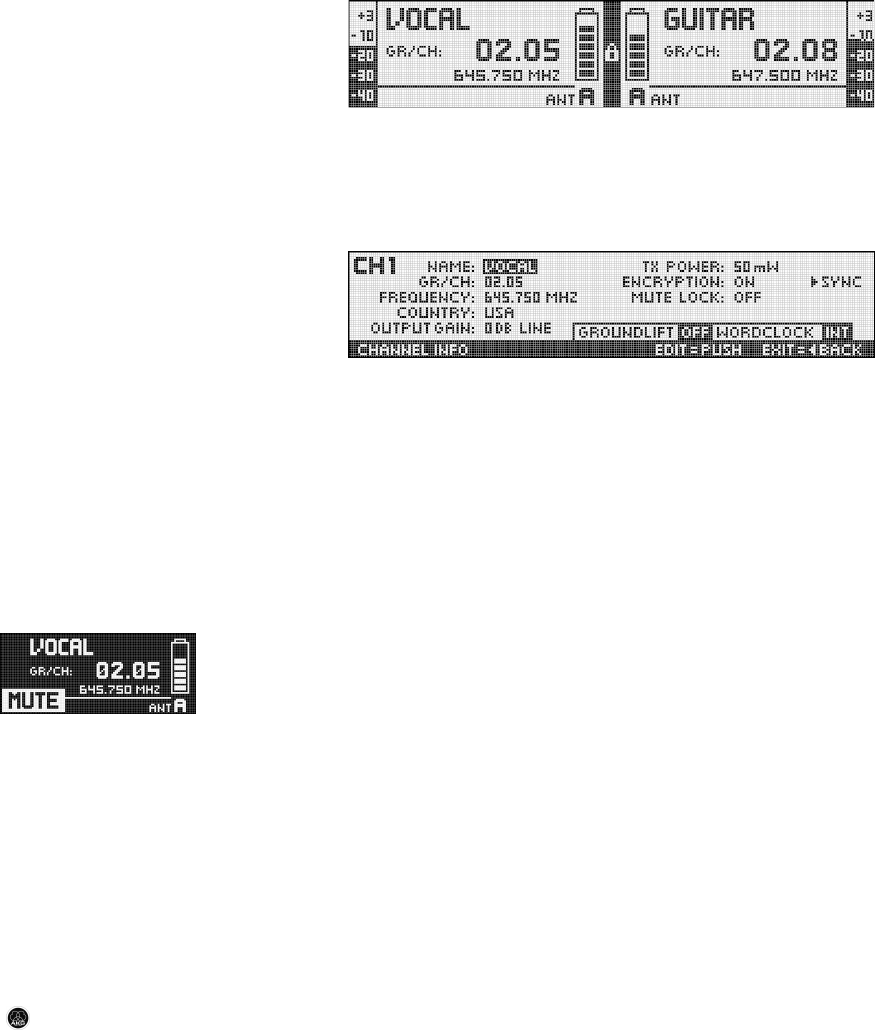
DMS 700 V1.00 9
BACK Button (4)
A short push will close the actual menu and all unconfirmed values are erased Holding the BACK key will
close all menus, all unconfirmed values are erased and the general window is activated.
DSP Button (2)
The DSP button provides a bypass function for LOW CUT, EQ, COMPRESSOR and LIMITER for each
channel individually.
Checking Audio Signal – Headphone CH1 / CH2 Buttons (6)
For monitoring the audio signal connect headphones with a ¼ Inch/6.3mm TRS plug to the headphone
output (7). To activate the audio output, push the headphone CH1 or CH2 button next to the headphone
socket briefly. To deactivate the audio push the headphone CH1 or CH1 button for more than 1 sec. You
can adjust the headphone’s volume with the SETUP WHEEL directly after pushing the headphone
section’s CH1 or CH2 button
6. Display
General Window
The general window shows all necessary parameters for operation. In addition to a freely-selectable
name, the current frequency, the current group and channel, you can see the audio level, the active
antenna and the remaining use time of the transmitter’s battery. In case of a critical fault condition (audio
mute, low battery, audio clip) you will see a warning message.
Channel Information Window
Via the channel Information window you can get a quick overview about the tuning parameters
(group/channel, frequency, name, country, output gain, transmission power, encryption and mute lock). All
these parameters can be set and synchronized. The GROUNDLIFT and WORDCLOCK Information show
you the current state. To enter the channel information window, simply push the CH1 or CH2 button in the
general window.
Battery status information
The battery symbols on the transmitter (C) and receiver (C) provides you with the transmitter’s remaining
battery capacity at a glance. Every one of the segment equal approximately 1 hour of remaining battery
life. If no battery voltage is detected or the information is invalid, no information is shown on the display.
When approximately 1 hour battery life remains, the warning text LOW BATT appears and the LED ring
turns red.
Audio Meter
The audio meter (E) indicates the audio output level of the receiver. To match the receiver’s output level to
the connected mixer, you can adjust the level with the IN GAIN parameter in the DSP sub-menu. The
output level is not properly adjusted if the audio meter is off-scale or if the input on the connected device is
overloaded.
MUTE Information (F)
The audio output is muted. The status LED ring (11) is lit red. Since power and the RF section remain ON,
no unwanted noise will become audible from the sound system when you mute the audio signal.
Antenna Information
The DSR 700 receiver has an integrated antenna splitter and operates with a special digital true-diversity
design. The antenna display information (H) indicates the active antenna.
Status & Warning Information
The STATUS & Warning Information gives you a visual warning to alert you to when selectable critical
system conditions occur. If one of the selected conditions occurs, the LED ring (11) around the SETUP
control will change from green to red and a warning message will appear on the display that describes the
current fault condition. The warning messages appear in the order of priority. Depending on the warning, a
big information (1
st
row) is permanent or only for 5 sec. visible. A small information (2
nd
row) is active as
long as the warning is not confirmed. The selected warning functions are active in LOCK and ACTIVE
mode. To delete a warning message from the display, press the SETUP control briefly.
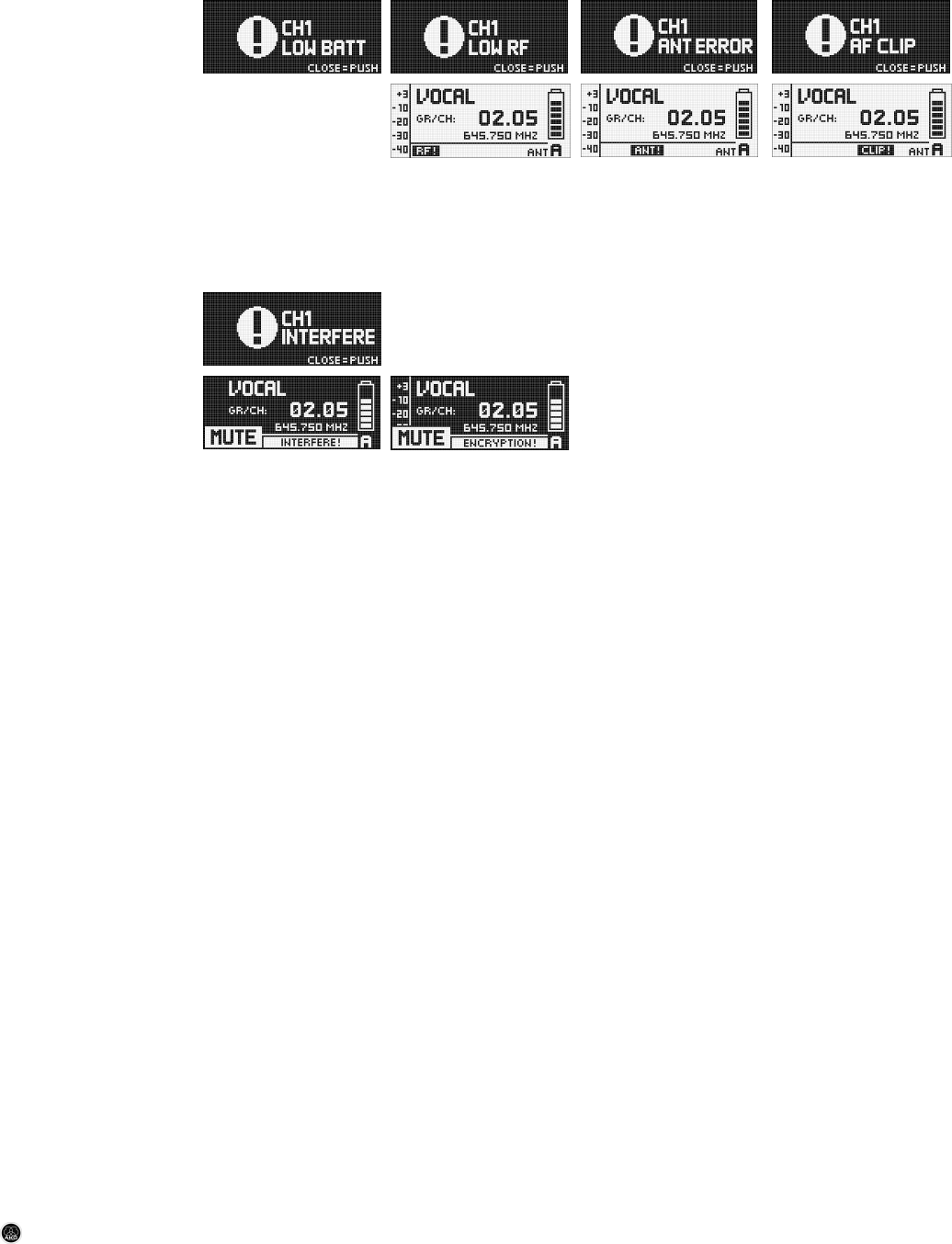
DMS 700 V1.00 10
Status Information in order of priority:
1. LOW BAT: Transmitter battery capacity is low. Permanent big warning and red LED ring
2. AF CLIP: Audio overload of transmitter’s A/D converter. The Red LED ring lights and a big warning
message lasts for 5 sec. or as long as this condition occurs. Small warning message in main
window lasts until the warning is deleted.
3. RF LOW: The field strength of the received RF signal is so low that the receiver’s audio output is
muted to prevent unwanted noise. Red LED ring and big warning lasts for 5 sec. or as long as
this occurs. Small warning in main window lasts until the warning is deleted.
LOW BATT: RF Low: Antenna Error: Audio Clip:
Warning Information in order of priority:
1. INTERFERE: Signal interference from other wireless systems, TV, radio, CB radios, or defective
electrical appliances or installations is detected.
2. ENCRYPTION: The Encryption scheme is not set properly.
Interference Encryption Error:
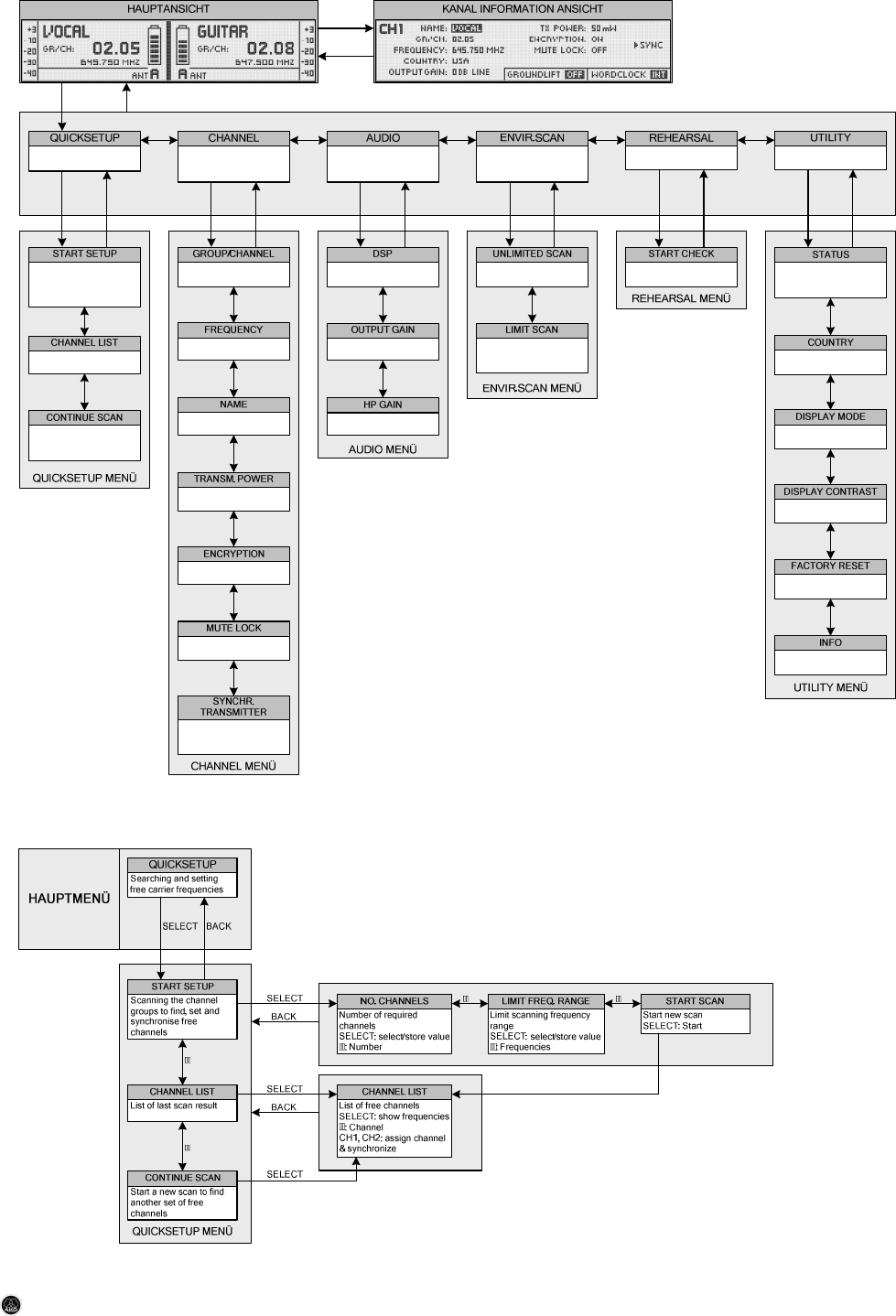
DMS 700 V1.00 11
7. DSR 700 Menu
Searching and setting
free carrier frequencies
Setting parameter
manually
Synchronize channel
Setting audio effects:
gain, low cut, EQ,
compressor and limiter
Searching frequency
band for active radio
frequencies.
Checking RF reception
area
General Settings
Scanning the channel
groups to find, set and
synchronize free
channels
List of last scan result
Start a new scan to find
another set of free
channels
Setting group and
channel manually
Setting frequency
manually
Assigning a name for the
channel
Setting transmitter
RF output power
Turning ON/OFF
encryption
Deactivate the transmitter
audio mute button
Synchronize all values of
the transmitter via
infrared
Setting audio effects
Setting audio output level
Adjusting headphone
volume
Searching entire
frequency band
Searching only a certain
part of the frequency
band
Checking RF reception
area
Programming a visual
warning for critical
conditions
Setting spezial frequency
presets
Changing the display
appearance
Changing the display
contrast
Reseting all parameters
to their default values
Calling up software and
hardware information
BACKSELECT
BACKSELECT BACKSELECT BACKSELECT BACKSELECT BACKSELECTBACKSELECT
CH1/CH2
BACK
Quicksetup – Menu
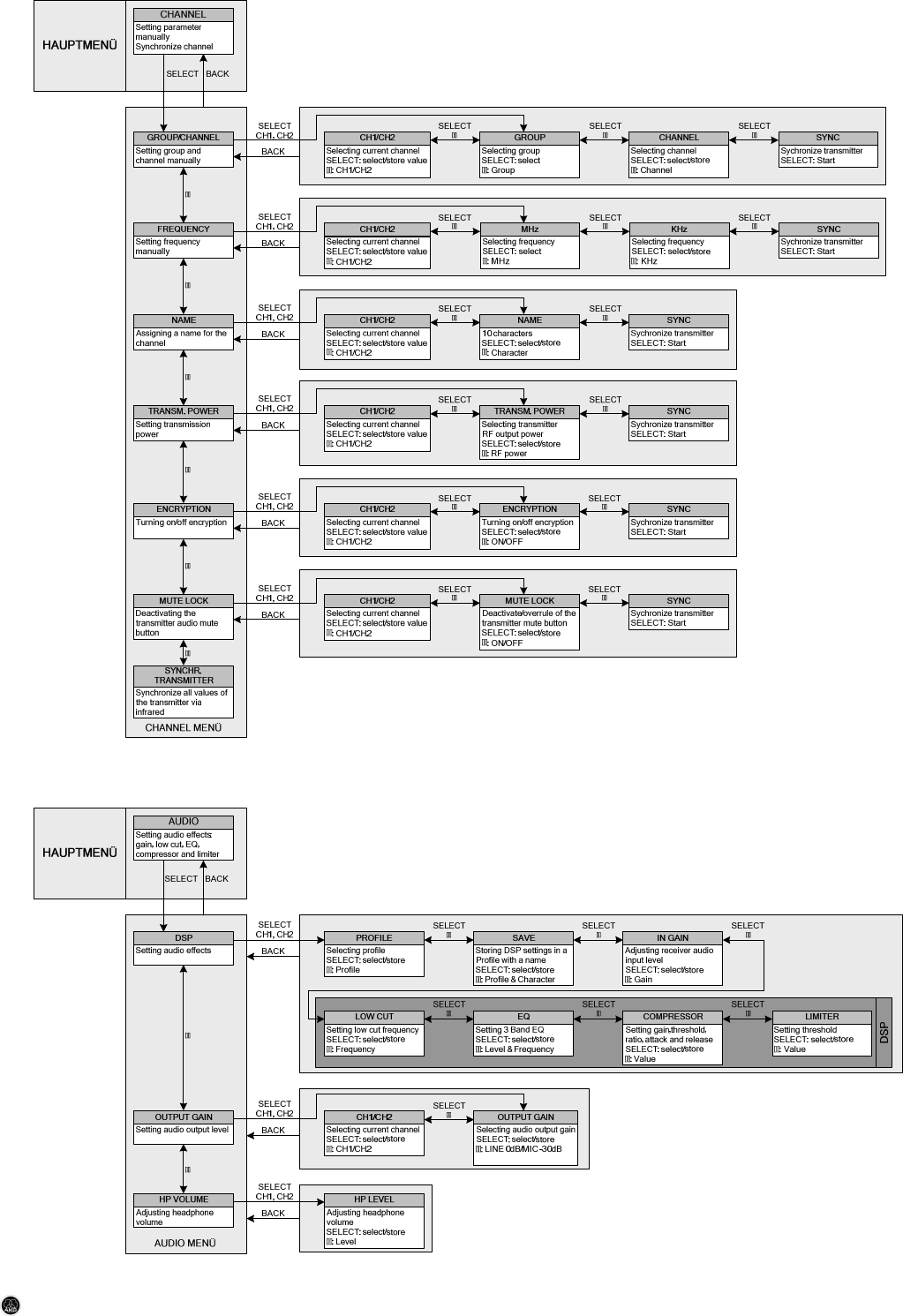
DMS 700 V1.00 12
Channel – Menu
AUDIO – Menu
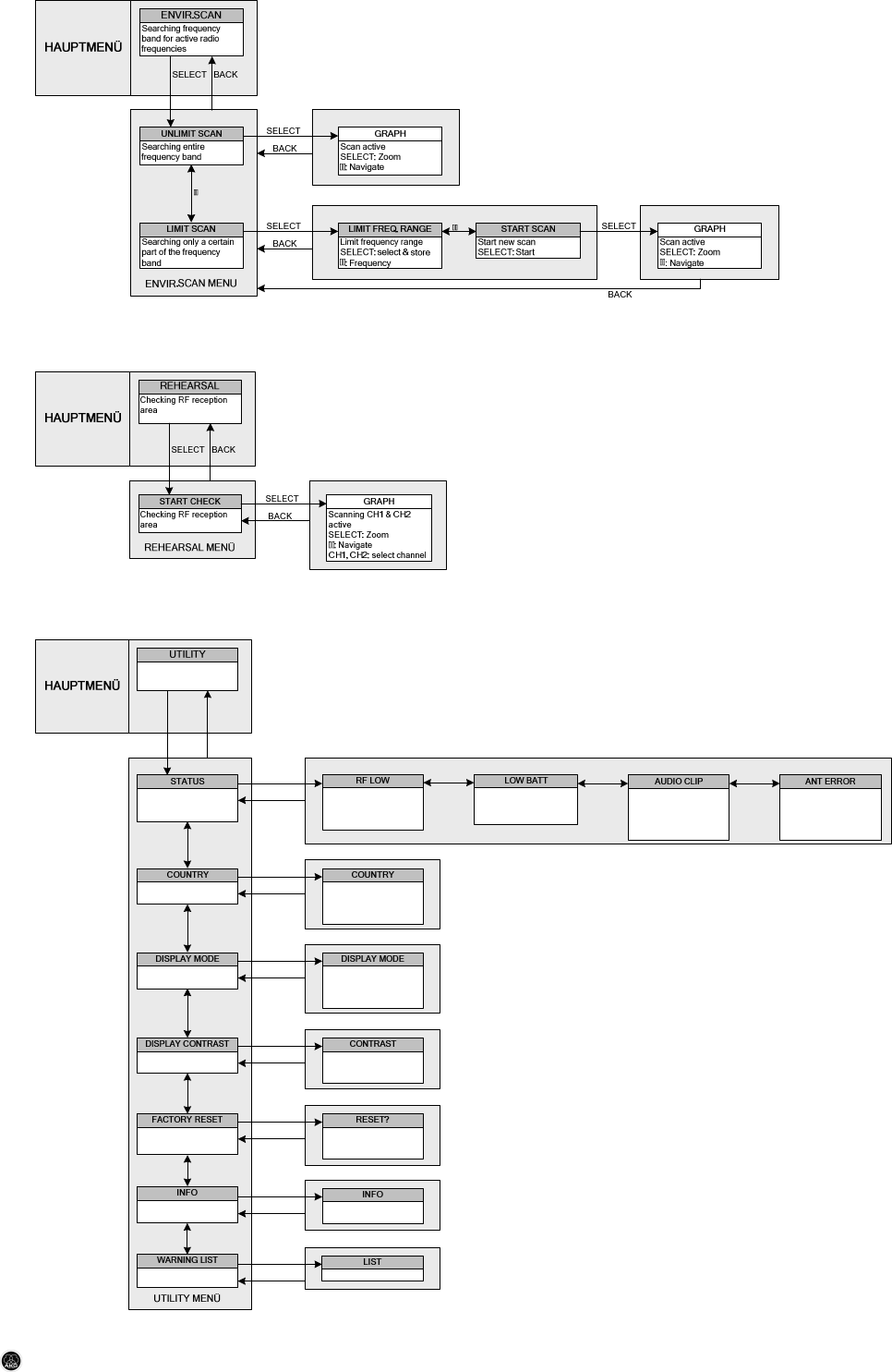
DMS 700 V1.00 13
Envir. Scan – Menu
Rehearsal – Menu
Utility – Menu
Last 25 warnings
SELECT BACK
General Settings
Programming a visual
warning at critical
conditions
Setting spezial frequency
presets
Changing the display
appearance
Changing the display
contrast
Reseting all parameters
to their default values
Calling up software and
hardware information
Warning: no RF reception
of transmitter
SELECT: select/store
: ON/OFF
Warning: transmitter remaining
battery capacity is low
SELECT: select/store
: ON/OFF
BACK
SELECT
SELECT
Warning: receiver has a
problem with an antenna
input
SELECT: select/store
: ON/OFF
Setting standard or
spezial frequency presets
SELECT: select/store
: Country
BACK
SELECT
Switching between 4
given appearances
SELECT: select/store
: Mode
BACK
SELECT
Selecting display contrast
SELECT: select/store
: Value
BACK
SELECT
Reseting all parameters
to their default values
: YES/NO
BACK
SELECT
Software and hardware
version
BACK
SELECT
: Navigate
BACK
SELECT
Warning: audio overload
at transmitter input A/D
converter
SELECT: select/store
: ON/OFF
SELECT
SELECT
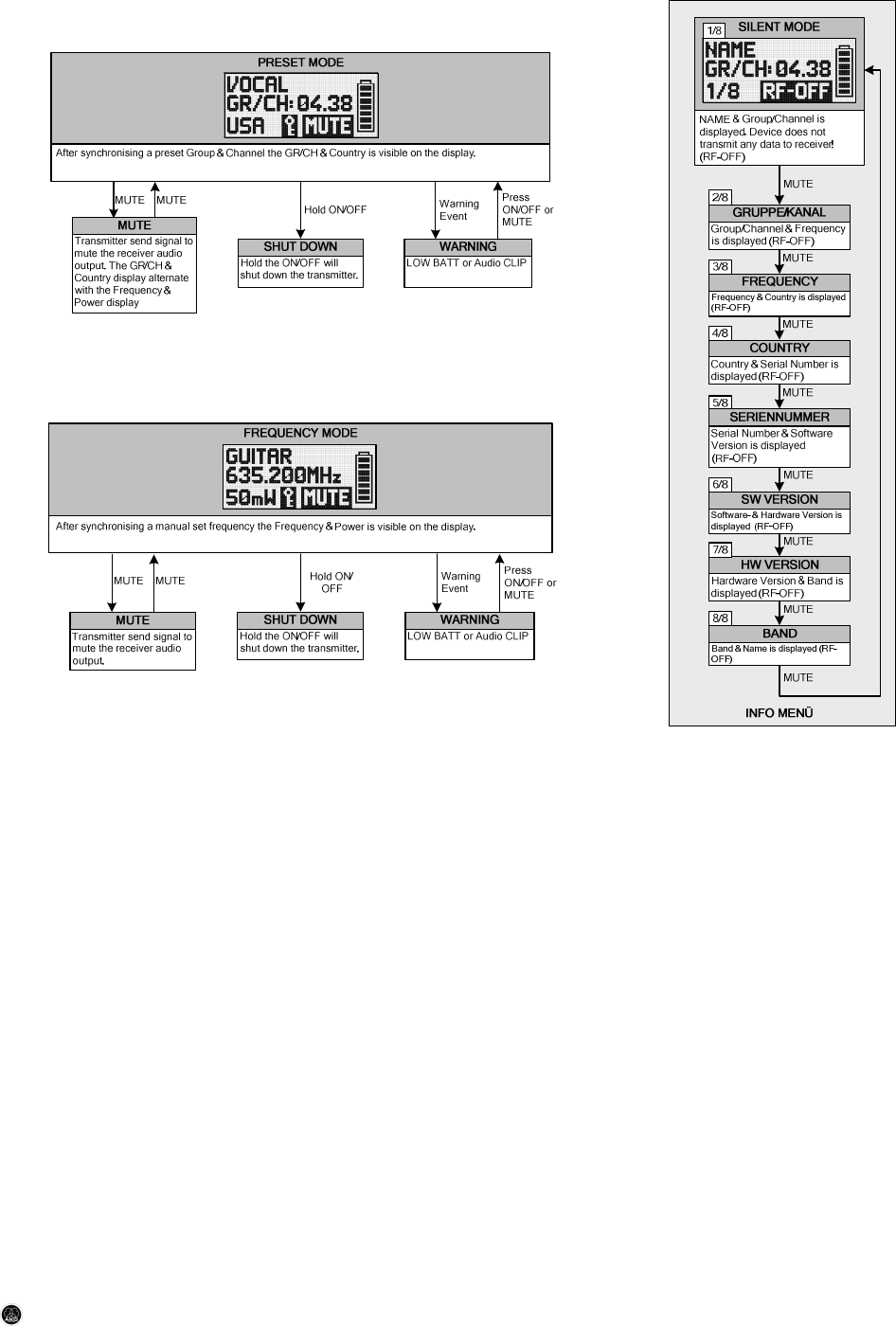
DMS 700 V1.00 14
8. DPT 700 / DHT 700 Menu
Standard Startup
ON/OFF Button
Preset Mode
Frequency Mode
Silent Mode Startup
ON/OFF & MUTE Button

DMS 700 V1.00 15
9. Function Description
Quicksetup
The DSR 700 is designed for use in large multi-channel systems. To find intermodulation-free carrier
frequencies quickly and easily, we recommend using the QUICKSETUP function to find all required
channel from the same Group within the same Preset. To start the QUICK SETUP, push the START
SETUP Menu, set the required channel number and if frequency ranges and start the scan. The scan
procedure can take up to one minute. The CHANNEL LIST shows you the free channels in a user-friendly
list. To assign and synchronize a free channel to the receiver you can use the channel button. Use the
CONTINUE SCAN sub-menu to search for other frequencies
Channel Menu
All channel-specific parameters like GROUP/CHANNEL, FREQUENCY, NAME, TRANSMISSION
POWER, ENCRYPTION and MUTE LOCK can be set and adjusted manually.
Group and Channel
The DSR 700 receiver provides frequency groups with specially-calculated frequencies. In the
GROUP/CHANNEL menu you can set and synchronize a channel(frequency) manually. Make certain that
all selected channel are from the same Group within the same Preset. To find free channels we
recommend using the QUICKSETUP function.
Frequency
Using the FREQUENCY sub-menu, the DSR 700 receiver allows frequency adjustments in 25-kHz-steps.
Name
You can enter any name (the name of performer or instrument, etc) for each channel.
Transm. Power
The TRANSM.POWER sub-menu lets you adjust the RF output power of the synchronized transmitter.
Encryption
If you turn on the encryption function, the receiver will calculate a unique key every time that you
synchronize the transmitter. The receiver uploads the key during the infrared synchronization with the
transmitter. You can not readout the encryption key and it is not possible to set two transmitters to the
same key! If you have to work with a backup transmitter you must turn off the signal encryption.
Mute Lock
The MUTE LOCK deactivates the mute button on the transmitter. You can override the transmitter if you
set the MUTE LOCK at the receiver afterwards!
Synchronization
During the infrared synchronization the receiver overwrites all previously-set values (Group/Channel,
frequency, name, transmission power, encryption key, and mute lock) of the transmitter.
To program the transmitter to previously-set values, start the transmitter synchronization in the receiver
menu and point the infrared sensor (4) on the transmitter at the infrared emitter (8) on the receiver from a
distance of 4 inches/10 cm max.
AUDIO Menu
DSP
The built-in digital signal processor allows you to control your audio signal directly in the receiver with
common processing features. The following dynamics processors are available:
• Input gain (gain)
• Low cut (frequency)
• 3-Band Equalizer (low gain, mid gain, mid-frequency, high gain)
• Compressor (threshold, ratio, gain, attack & release time)
• Limiter (threshold)
All values can be stored with a freely-selectable name in one of the nine profiles.
Attention! Profiles affect the settings on both channels! Changes effect both channels and all
values stored in profiles previously will be overwritten!
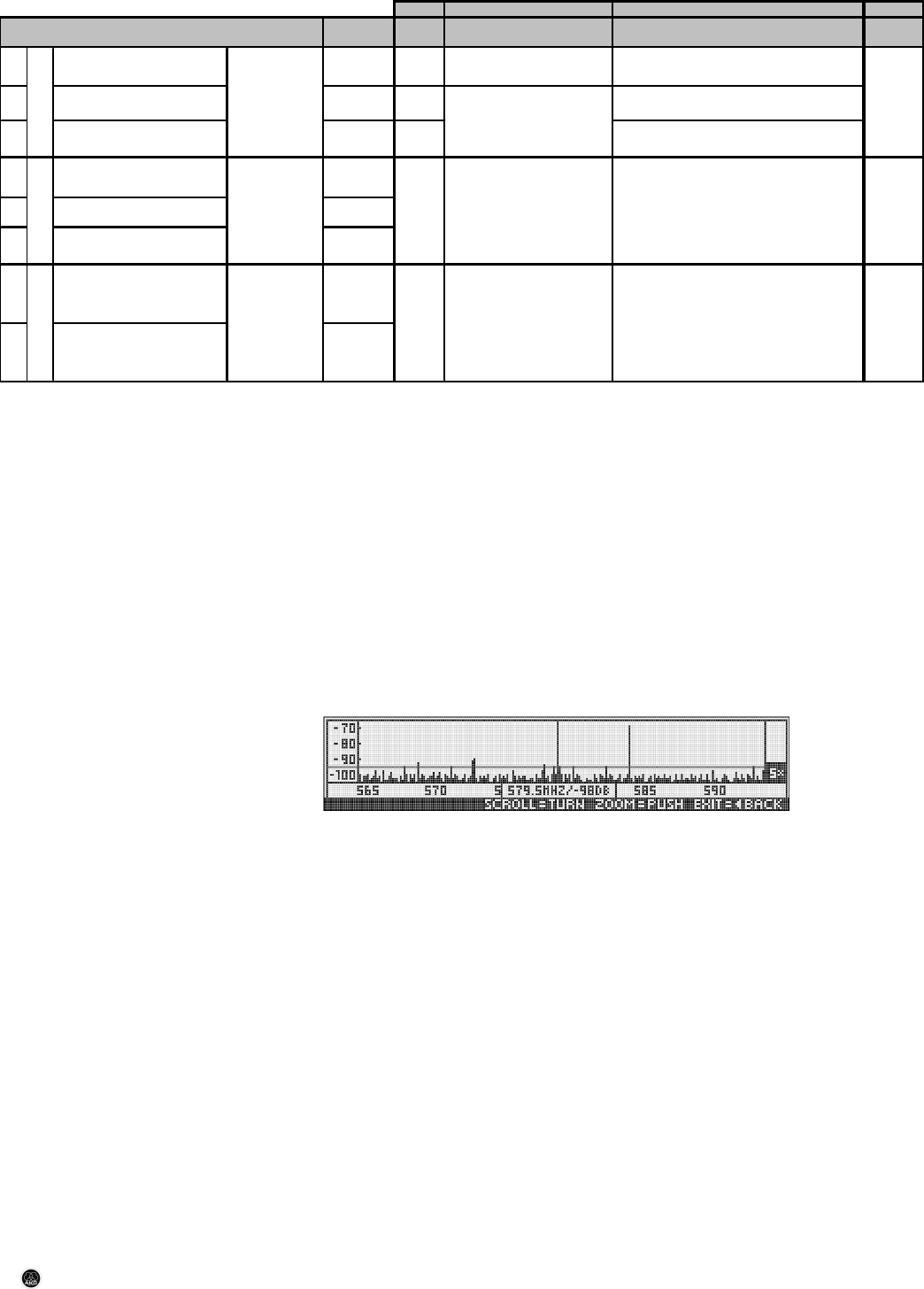
DMS 700 V1.00 16
DSP Button
The DSP button provides a bypass function for LOW CUT, EQ, COMPRESSOR and LIMITER for both
channels separately.
Output Gain
For matching the receiver’s BALANCED output level to the input gain of the connected equipment . If you
are using the MIC input of your mixer, the LINE 0 dB level might overload the input. In that case, set the
receiver’s output gain to MIC -30 dB to reduce the output level. The UNBALANCED line output level is not
adjustable
Environment Scan
The Environment Scan function converts the receiver into a spectrum analyzer. The UNLIMITED SCAN
automatically searches the receiver's entire frequency band ±6 MHz for active radio frequencies. The
LIMIT SCAN provides the possibility of scanning only a part of the receiver’s frequency range. During the
search, the audio output is muted and the display shows a frequency graph. You can navigate (CW, CCW)
and zoom (push) through the graph by using the SETUP Wheel.
Rehearsal – Sound Check
The Rehearsal Scan function converts the receiver to an RF recorder to check the RF level in your
reception area. Start this function and walk around the desired coverage area with the synchronized
transmitter. The graphic display shows you the received signal level in time. To mark some positions, you
can use the transmitter MUTE button to set markers on the receiver display. You can navigate (CW, CCW)
and zoom (push) through the graph by using the SETUP Wheel. The received signal level should never
drop below -85 dBm. You can optimize signal reception by changing the position of the connected
antennas.
DSP Profile - Factory default values
Low Cut Limiter
No. Profil Display User Input Gain
[dB]
Freq.
[Hz]
Low
[dB]
Mid
[dB]
MidFreq
[kHz]
High
[dB]
Threshold
[dB]
Ratio Gain
[dB]
Attack
[ms]
Release
[ms]
Threshold
[dB]
1Handheld Present HT 20 77 0 0 1.0 3.0 -30 2.1:1 3 1 71
2Headset Present PT 25 40 -25 1.5:1 5 6 207
3C555L Present C555 15 40 -25 1.5:1 5 6 207
4Handheld Music HT 10
5Headset Music PT 20
6C555L Music C555 10
7
Instrument
Microphone
mit
Bodypack
Instru PT Profi+Amateure,
Trompete, Tuba,
Drums 20
8
Guitar mit
Bodypack
Guitar PT E-Gitarre,
Bassgitarre,aktiv
e Akustikgitarre 0
Equalizer Compressor
Presenter
Amateure,
Powerpoint,
Kirche,
Ansprache 0
OFF
Music
Profi, SängerIn
Rockband,
Karaoke, Musical
40 OFF OFF 9
9
PT Instrument
OFF OFF OFF
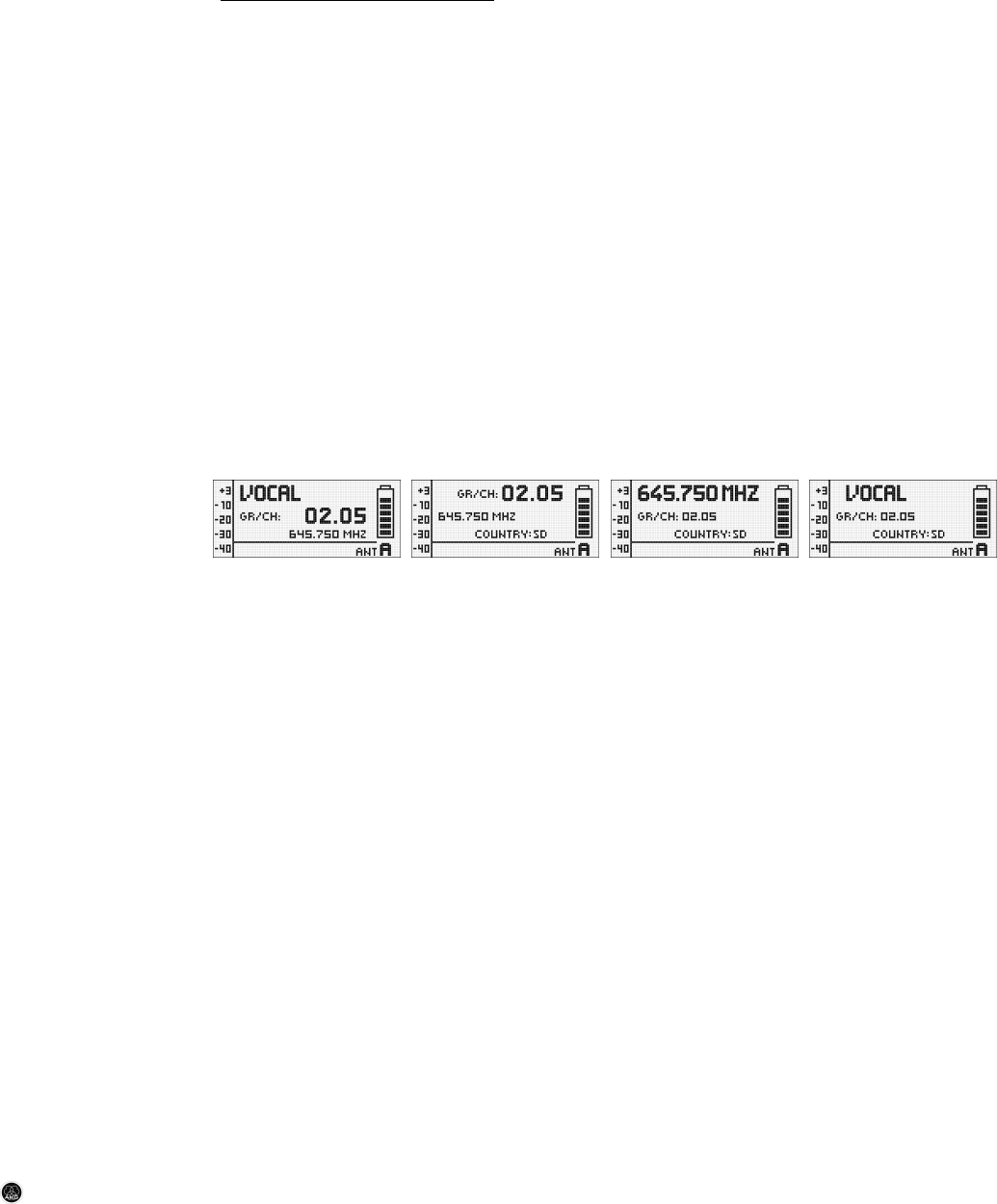
DMS 700 V1.00 17
Utilities Menu
Status
The STATUS sub-menu lets you activate a visual warning that alerts you when there are problems with
selected critical system conditions. If one of the selected conditions occurs, the LED ring around the
SETUP control will change from green to red and a warning message will appear on the display that
describes the problematic condition. The warning messages appear in the order of priority. Depending on
the warning, a big information message lasts only for 5 sec. visible. A smaller information message stays
active until it is confirmed.
The selected warning functions are active in LOCK and ACTIVE modes. To delete a warning message
from the display, press the SETUP control briefly.
Status Information in order of priority
LOW BAT
Transmitter’s remaining battery capacity is low. Permanent big warning and red LED ring.
AF CLIP
Audio overload of the transmitter’s A/D converter. Reduce the audio input level. Red LED ring and big
warning lasts for 5 sec. or as long as the condition occurs. Small warning in the main window lasts until
it is deleted.
RF LOW
The field strength of the received RF signal is so low that the receiver’s audio output is muted to prevent
unwanted noise. Red LED ring and big warning for 5 sec. or as long as occur. Small warning in main
window as long as not deleted.
ANT ERROR
The same antenna has been active for at least one minute. Check if antenna cable is broken or wrong
connected. Red LED ring and big warning for 5 sec. Small warning in main window as long as not
deleted.
Country
When you turn the receiver on for the first time, the receiver will ask you to set a country.
Normally you should use SD (Standard), EU (EUROPE) or US (USA). Only for special countries does the
internally-stored frequency presets have to be adjusted. In that case, these countries can be set.
Otherwise, please use the SD setting.
Display-Mode
This menu lets you change the display appearance. You can choose from 4 different displays:
MAIN: GROUP/CHANNEL: FREQUENCY: NAME :
Display Contrast
The Display Contrast sub-menu allows you to adjust the contrast of the display for use in different lighting
conditions
Factory Reset
The Factory Reset sub-menu allows you to reset all parameters to their default values.
Info
The INFO sub-menu lets you call up software and hardware information about your receiver and the
synchronized transmitter.
Warning List
WARNING LIST stores the last 25 warnings.
10.
Cleaning
Use a soft cloth moistened with water to clean the surfaces of the equipment.

DMS 700 V1.00 18
11. Troubleshooting
Problem Possible Cause / Remedy
No sound
• Interference from other wireless systems, TV, radio, CB radios, defective electrical appliances
or wiring.
• Transmitter is tuned to different frequency than receiver.
• Transmitter is "OFF" or transmitter MUTE switch set to "MUTE".
• Power cord is not connected to receiver and/or the power outlet.
• Receiver is OFF.
• Receiver is not connected to the sound system.
• Microphone or instrument is not connected to bodypack transmitter
• Transmitter batteries are not inserted properly.
• Transmitter batteries/battery pack dead.
• Transmitter is too far away from receiver
• Obstructions between transmitter and receiver are blocking the signal.
• Receiver is invisible from transmitter location.
• Receiver too close to metal objects.
• Software of the transmitter and receiver do not match.
Distortion • Gain Setting are not set properly.
• DSP settings are not set properly.
Momentary loss of sound
("dropouts") at some points
within performance area.
• Relocate receiver or re-orient the antennas. If dead spots persist, mark and avoid them.
• Transmitter is too far away from receiver.
Status / Error / Warning Problem / Remedy
RF LOW • The field strength of the received RF signal is so low that the receiver audio output is muted to
prevent unwanted noise. Re-locate receiver or use remote antennas
AF CLIP • Audio overload of transmitter A/D converter. Reduce the audio input level.
ANT ERROR • The same antenna has been active for at least one minute. Check if antenna cable(s) are
broken or incorrectly-connected.
LOW BATT • Transmitter battery capacity is low.
SYSTEM ERROR • Internal software error: Switch power to receiver OFF and back ON after about 10 seconds. If
the problem persists, contact your AKG Service Center.
RF ERROR / PLL ERROR • Receiver cannot lock on to the selected frequency. Confirm error (short push of SETUP-wheel)
and select a different frequency. If problem persists, contact your AKG Service Center.
UPDATE FIRMWARE • System is ready for software update. Switch power to receiver OFF and back ON after about
10 seconds. If problem persists, contact your AKG Service Center.
INTERFERE ERROR
• Transmission is being interfered from other wireless systems, TV, radio, CB radios, or
defective electrical appliances or installations. Change frequency or switch off interfering
device.
ENCRYPTION! • Encryption is not set properly. Synchronize transmitter.
• Interference from other DMS 700 transmitter.
SYNC Information Problem / Remedy
WRONG DEVICE • Transmitter frequency band does not match the receiver’s frequency band.
ERROR DEVICE • Error in transmitter ID data. If the problem occurs frequently, contact your AKG Service Center
TIMEOUT • No infrared data detected.

DMS 700 V1.00 19
12. Specifications
General – DMS 700 Digital Microphone System
Carrier frequency range 548.1 to 864.9 MHz
Switching bandwidth ≤ 155 MHz (country dependent)
Audio bandwidth 35 – 20 000 Hz (±3B)
T.H.D. ≤ 0.02 %
Signal/noise ratio (A-weighted) Analog: XLR balanced typ. 115 dB(A)
Digital: AES3 typ. 120 dB(A)
Audio sampling 32 Bit / 44.1 kHz
Modulation Digital
Bit rate < 200 kbps
Compression AKG premium audio compression technology
Latency 4 ms
Encryption YES
Temperature range 14 – 131°F / -10 – 55°C
DSR 700 – Digital True Diversity Receiver
Carrier frequency range Band 1: 548.1 to 697.9 MHz
Band 2: 710.1 to 861.9 MHz, 863.1 to 864.9 MHz
Switching Bandwidth ≤ 155 MHz (country dependent)
Channels 2 (Dual Receiver)
Sensitivity 10dBµV / -97dBm
Image & Spurious Rejection ≥ 95dB
Receiver type super heterodyne
Diversity system digital true diversity
Antenna inputs 2 x 50Ω BNC female connector
Audio outputs 2 x analog: XLR sockets balanced
2 x analog: ¼ inch / 6.3mm jack sockets unbalanced
1 x digital: AES3 XLR socket (48 kHz) with Wordclock IN (BNC, 48 kHz)
Audio output level XLR balanced: +12 dBu (max.)
Low cut 0 – 300 Hz
Equalizer 3 Band (Parameter: low gain, mid gain, mid frequency, high gain)
Compressor dBx (parameter: gain, threshold, ratio, attack, release)
Limiter dBx (parameter: threshold)
Transmitter battery meter 7- digit transmitter battery information
PC interface Ethernet via HUB 4000 Q, HiQnet System Architect Software
Power supply 90 – 240 VAC, 50-60 Hz, 0.4A
Dimensions Standard 1U- rack
18.9 (W) x 1.7(H) x 7.87 (D)inch / 480 (W) x 43 (H) × 200 (D)mm
Net weight 81oz / 2.3kg
DPT 700 – Digital Bodypack Transmitter
Carrier frequency range Band 1: 548.1 to 697.9 MHz
Band 2: 710.1 to 861.9 MHz, 863.1 to 864.9 MHz
Switching bandwidth ≤ 155 MHz (country dependent)
RF output power 10, 20, 30, 50mW (ERP max.) software adjustable (country dependent)
Spurious ≤ -70 dBc
Antenna ¼- wave antenna
Audio input TB3M / 3-pol. mini-XLR socket (max. 2.5Vrms)
Battery life ≥ 8 Std. with 2x 1.5V LR6 AA batteries
≥ 8 Std. with 2x 1.2V AA rechargeable batteries (NiMH, >2100 mAh)
Dimensions 3.3(W)x2.5(H)x0.86(D)inch / 83.5(W)×64.1(H)x22(D)mm
Net weight 2.9oz / 82g without batteries
DHT 700 – Digital Handheld Transmitter
Carrier frequency range Band 1: 548.1 to 697.9 MHz
Band 2: 710.1 to 861.9 MHz, 863.1 to 864.9 MHz
Switching Bandwidth ≤ 155 MHz (country-dependent)
RF output power 10, 20, 30, 50mW (ERP max.) software-adjustable (country-dependent)
Spurious ≤ -70 dBc
Antenna Built-In helical antenna
Microphone element DHT 700 D5 – dynamic-microphone (super cardioid)
DHT 700 C5 – condenser-microphone (cardioid)
Max. SPL DHT 700 D5 ≤ 140 dB SPL
DHT 700 C5 ≤ 140 dB SPL
Battery life ≥ 8 Std. with 2x 1.5V LR6 AA batteries
≥ 8 Std. with 2x 1.2V AA rechargeable batteries (NiMH, >2100 mAh)
Dimensions 2(Φ)×9.1(L)inch / 52(Φ)×231(L)mm
Net weight 11.8oz / 336g
This equipment conforms to the standards listed in the Declaration of Conformity. To order a free copy of the Declaration of Conformity,
visit http://www.akg.com or contact sales@akg.com.

Microphones · Headphones · Wireless Microphones · Wireless Headphones · Headsets · Electroacoustical Components
AKG Acoustics GmbH
Lemböckgasse 21–25, A-1230 Vienna/AUSTRIA, phone: (+43-1) 86654-0*
E-mail: sales@akg.com
For other products and distributors worldwide visit www.akg.com
Specifications subject to change without notice
Printed in China. 01/07/9100 U 1286